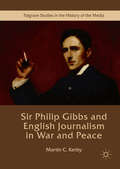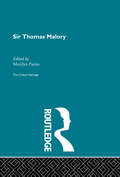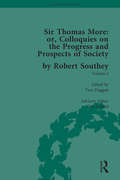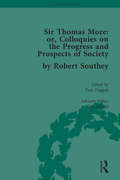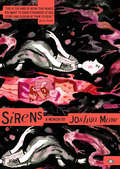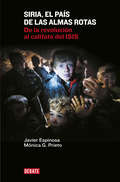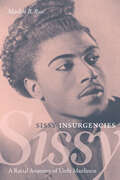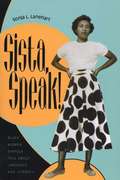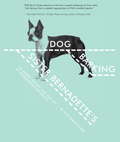- Table View
- List View
Sir Philip Gibbs and English Journalism in War and Peace
by Martin C. KerbySir Philip Gibbs was one of the most widely read English journalists of the first half of the twentieth century. Prior to 1914 he reported on industrial unrest, Ireland, the suffragette movement, royal births, deaths and coronations, the sinking of the Titanic, and the Balkan War in 1912. This coverage of his writing offers a broad insight into British social and political developments, government and press relations, propaganda, and war reporting during the First World War. As a war correspondent on the Western Front, his articles, which appeared on both sides of the Atlantic, did much to shape civilian attitudes during the First World War and its immediate aftermath. Many critics dismissed Gibbs' work as propaganda and his acceptance of a knighthood in 1920 as a reward. His writing in the post-war years covered the full range of inter-war European politics, the Second World War, and the Cold War.
Sir Philip Sidney and the Interpretation of Renaissance Culture: The Poet in his Time and in Ours (Routledge Revivals)
by Gary F. WallerFirst published in 1984, Sir Philip Sidney and the Interpretation of Renaissance Culture is a collection of essays which reflect the diversity of contemporary approaches to the controversial figure of Sir Philip Sidney, and range from the ‘historicist’ to the ‘revisionist’. Interest in the work of Sir Philip Sidney, in the cultural significance of his ‘Circle’ in the late Elizabethan age and the following years, has always been a subject of interest. Ever since Sidney’s friend Fulke Greville saw his early death as a watershed in English history, the place of this aristocratic poet in literary, cultural and even popular tradition has been momentous. Elevated to mythological status by his contemporaries who survived, he has not lost his power to attract and charm readers of all kids. This book will be of interest to students of literature and history.
Sir Thomas Malory: The Critical Heritage
by Marylyn ParinsFirst published in 2002. Routledge is an imprint of Taylor & Francis, an informa company.
Sir Thomas More V2 (The Pickering Masters)
by Robert SoutheyIn 1829 Robert Southey published a book of his imaginary conversations with the original Utopian: Sir Thomas More; or Colloquies on the Progress and Prospects of Society. The product of almost two decades of social and political engagement, Colloquies is Southey’s most important late prose work, and a key text of late 'Lake School' Romanticism. It is Southey’s own Espriella’s Letters (1807) reimagined as a dialogue of tory and radical selves; Coleridge’s Church and State (1830) cast in historical dramatic form. Over a series of wide-ranging conversations between the Ghost of More and his own Spanish alter-ego, ‘Montesinos’, Southey develops a richly detailed panorama of British history since the 1530s - from the Reformation to Catholic Emancipation. Exploring issues of religious toleration, urban poverty, and constitutional reform, and mixing the genres of dialogue, commonplace book, and picturesque guide, the Colloquies became a source of challenge and inspiration for important Victorian writers including Macaulay, Ruskin, Pugin, and Carlyle.
Sir Thomas More: Or Colloquies On The Progress And Prospects Of Society (The Pickering Masters #1)
by Robert SoutheyIn 1829 Robert Southey published a book of his imaginary conversations with the original Utopian: Sir Thomas More; or Colloquies on the Progress and Prospects of Society. The product of almost two decades of social and political engagement, Colloquies is Southey’s most important late prose work, and a key text of late 'Lake School' Romanticism. It is Southey’s own Espriella’s Letters (1807) reimagined as a dialogue of tory and radical selves; Coleridge’s Church and State (1830) cast in historical dramatic form. Over a series of wide-ranging conversations between the Ghost of More and his own Spanish alter-ego, ‘Montesinos’, Southey develops a richly detailed panorama of British history since the 1530s - from the Reformation to Catholic Emancipation. Exploring issues of religious toleration, urban poverty, and constitutional reform, and mixing the genres of dialogue, commonplace book, and picturesque guide, the Colloquies became a source of challenge and inspiration for important Victorian writers including Macaulay, Ruskin, Pugin, and Carlyle.
Sir Thomas More: or, Colloquies on the Progress and Prospects of Society, by Robert Southey (The Pickering Masters)
by Tim Fulford Tom DuggettFirst Published in 2017. Routledge is an imprint of Taylor & Francis, an Informa company.
Sir Walter Scott on Novelists and Fiction (Routledge Revivals)
by Ioan WilliamsFirst published in 1968, this collection of essays and reviews represents all that Sir Walter Scott wrote on the subject of novels and novelists, and will be invaluable for the study of Scott, both as novelist and critic. The work provides a survey of the novel at an important period of its development and offers an historical perspective not normally available in one volume.
Sirappu Tamizh (Advanced Tamil) 11th Standard - Tamilnadu Board
by Training State Council of Educational ResearchSirappu Tamizh (Advanced Tamil) Textbook for the 11th Standard Students, preparing for Tamil Nadu State Board Exam.
Sirappu Tamizh (Advanced Tamil) 12th Standard - Tamilnadu Board
by Training State Council of Educational ResearchSirappu Tamizh (Advanced Tamil) Textbook for the 12th Standard Students, preparing for Tamil Nadu State Board Exam.
Sirens
by Joshua MohrAcclaimed novelist Joshua Mohr provides a captivating and complicated account of his years of substance abuse and culpability in his non-fiction debut. Employing the characterization and chimerical prose for which he has been lauded, Mohr traces his childhood swilling fuzzy navels as a latch-key kid, through his first failed marriage, parenthood, heart-surgery, and his everyday struggle against relapse.
Sirens of the Western Shore: The Westernesque Femme Fatale, Translation, and Vernacular Style in Modern Japanese Literature
by Indra LevyIndra Levy introduces a new archetype in the study of modern Japanese literature: the "Westernesque femme fatale," an alluring figure who is ethnically Japanese but evokes the West in her physical appearance, lifestyle, behavior, and, most important, her use of language. She played conspicuous roles in landmark works of modern Japanese fiction and theater.Levy traces the lineage of the Westernesque femme fatale from her first appearance in the vernacularist fiction of the late 1880s to her development in Naturalist fiction of the mid-1900s and, finally, to her spectacular embodiment by the modern Japanese actress in the early 1910s with the advent of Naturalist theater. In all cases the Westernesque femme fatale both attracts and confounds the self-consciously modern male intellectual through a convention-defying use of language. What does this sirenlike figure reveal about the central concerns of modern Japanese literature? Levy proposes that the Westernesque femme fatale be viewed as the hallmark of an intertextual exoticism that prizes the strange beauty of modern Western writing.By illuminating the exoticist impulses that gave rise to this archetype, Levy offers a new understanding of the relationships between vernacular style and translation, original and imitation, and writing and performance within a cross-cultural context. A seamless blend of narrative, performance, translation, and gender studies, this work will have a profound impact on the critical discourse on this formative period of modern Japanese literature.
Siri Kannada 1st Language Part-1 class 8 (Revised 2024) - Karnataka Board: 8ನೇ ತರಗತಿ ಸಿರಿ ಕನ್ನಡ ಪ್ರಥಮ ಭಾಷೆ (ಪರಿಷ್ಕೃತ 2024) ಭಾಗ -1
by Karnataka Patyapustaka Sanghaಇದು ಪಠ್ಯಕ್ರಮದ ಪ್ರಕಾರ KTBS ನಿಂದ 8 ನೇ ತರಗತಿಯ ಕನ್ನಡ ಮಾಧ್ಯಮದ ವಿದ್ಯಾರ್ಥಿಗಳಿಗೆ ಶೈಕ್ಷಣಿಕ ಪಠ್ಯ ಪುಸ್ತಕವಾಗಿದೆ.
Siri Kannada 1st Language Part-2 class 8 (Revised 2024) - Karnataka Board: 8ನೇ ತರಗತಿ ಸಿರಿ ಕನ್ನಡ ದ್ವಿತೀಯ ಭಾಷೆ (ಪರಿಷ್ಕೃತ 2024) ಭಾಗ -2
by Karnataka Patyapustaka Sanghaಇದು ಪಠ್ಯಕ್ರಮದ ಪ್ರಕಾರ KTBS ನಿಂದ 8 ನೇ ತರಗತಿಯ ಕನ್ನಡ ಮಾಧ್ಯಮದ ವಿದ್ಯಾರ್ಥಿಗಳಿಗೆ ಶೈಕ್ಷಣಿಕ ಪಠ್ಯ ಪುಸ್ತಕವಾಗಿದೆ.
Siri Kannada 1st Language Part-2 class 9 (Revised 2024) - Karnataka Board: 9ನೇ ತರಗತಿ ಸಿರಿ ಕನ್ನಡ ಪ್ರಥಮ ಭಾಷೆ (ಪರಿಷ್ಕೃತ 2024) ಭಾಗ -2
by Karnataka Patyapustaka Sanghaಇದು ಪಠ್ಯಕ್ರಮದ ಪ್ರಕಾರ KTBS ನಿಂದ 9 ನೇ ತರಗತಿಯ ಕನ್ನಡ ಮಾಧ್ಯಮದ ವಿದ್ಯಾರ್ಥಿಗಳಿಗೆ ಶೈಕ್ಷಣಿಕ ಪಠ್ಯ ಪುಸ್ತಕವಾಗಿದೆ.
Siria, el país de las almas rotas: De la revolución al califato del ISIS
by Javier Espinosa Mónica G. PrietoEl estremecedor relato de la guerra civil siria desde dentro, desde primera línea, por los reporteros Javier Espinosa y Mónica G. Prieto. Cuando la revolución se extendió por Siria en marzo de 2011, pocos podían esperar que manifestaciones pacíficas fueran reprimidas con bombardeos aéreos, armas químicas y una cuidada estrategia para fomentar el odio sectario que avivó las diferencias religiosas consagrando al país al conflicto civil y haciendo de Siria un tablero de juegos para el mundo. Conscientes de la dimensión del problema, Javier Espinosa y Mónica G. Prieto cubrieron desde los primeros días los entresijos de la tragedia, cruzando ilegalmente fronteras y exponiéndose a la salvaje represión del régimen de El Asad hasta que el extremismo devoró la revolución y el secuestro de uno de ellos, a manos del ISIS, elevó hasta lo insoportable su nivel de implicación. Inquietante y estremecedor, este vibrante relato desenmaraña las complejas dinámicas subyacentes al conflicto civil sirio, exponiendo un tema de total y triste actualidad, contado desde el terreno y desde dentro.
Sissy Insurgencies: A Racial Anatomy of Unfit Manliness
by Marlon B. RossIn Sissy Insurgencies Marlon B. Ross focuses on the figure of the sissy in order to rethink how Americans have imagined, articulated, and negotiated manhood and boyhood from the 1880s to the present. Rather than collapsing sissiness into homosexuality, Ross shows how sissiness constitutes a historically fluid range of gender practices that are expressed as a physical manifestation, discursive epithet, social identity, and political phenomenon. He reconsiders several black leaders, intellectuals, musicians, and athletes within the context of sissiness, from Booker T. Washington, George Washington Carver, and James Baldwin to Little Richard, Amiri Baraka, and Wilt Chamberlain. Whether examining Washington’s practice of cleaning as an iteration of sissiness, Baldwin’s self-fashioned sissy deportment, or sissiphobia in professional sports and black nationalism, Ross demonstrates that sissiness can be embraced and exploited to conform to American gender norms or disrupt racialized patriarchy. In this way, sissiness constitutes a central element in modern understandings of race and gender.
Sista, Speak!: Black Women Kinfolk Talk about Language and Literacy
by Sonja L. LanehartThe demand of white, affluent society that all Americans should speak, read, and write "proper" English causes many people who are not white and/or middle class to attempt to "talk in a way that feel peculiar to [their] mind," as a character in Alice Walker's The Color Purple puts it.<P><P> In this book, Sonja Lanehart explores how this valorization of "proper" English has affected the language, literacy, educational achievements, and self-image of five African American women--her grandmother, mother, aunt, sister, and herself.<P>Through interviews and written statements by each woman, Lanehart draws out the life stories of these women and their attitudes toward and use of language. Making comparisons and contrasts among them, she shows how, even within a single family, differences in age, educational opportunities, and social circumstances can lead to widely different abilities and comfort in using language to navigate daily life. Her research also adds a new dimension to our understanding of African American English, which has been little studied in relation to women.
Sister Bernadette's Barking Dog
by Kitty Burns FloreyOnce wildly popular in grammar schools across the country, sentence diagramming has fallen out of fashion. But are we that much worse for not knowing the word-mapping method?Now, in this illustrated personal history that any language lover will adore, Kitty Burns Florey explores the rise and fall of sentence diagramming, including its invention by a mustachioed man named Brainerd "Brainy" Kellogg and his wealthy accomplice Alonzo Reed ... the inferior "balloon diagram" predecessor ... and what diagrams of sentences by Hemingway, Welty, Proust, Kerouac and other famous writers reveal about them.Florey also offers up her own common-sense approach to learning and using good grammar. And she answers some of literature's most pressing questions: Was Mark Twain or James Fenimore Cooper a better grammarian? What are the silliest grammar rules? And what's Gertude Stein got to do with any of it?
Sister Carrie (SparkNotes Literature Guide Series)
by SparkNotesSister Carrie (SparkNotes Literature Guide) by Theodore Dreiser Making the reading experience fun! Created by Harvard students for students everywhere, SparkNotes is a new breed of study guide: smarter, better, faster. Geared to what today's students need to know, SparkNotes provides: *Chapter-by-chapter analysis *Explanations of key themes, motifs, and symbols *A review quiz and essay topicsLively and accessible, these guides are perfect for late-night studying and writing papers
Sister in Sorrow: Life Histories of Female Holocaust Survivors from Hungary
by Ilana RosenSister in Sorrow offers a glimpse into the world of Hungarian Holocaust survivors through the stories of fifteen survivors, as told by thirteen women and two spouses presently living in Hungary and Israel. Analyzing the accounts as oral narratives, author Ilana Rosen uses contemporary folklore studies methodologies to explore the histories and the consciousness of the narrators as well as the difficulty for present-day audiences to fully grasp them. Rosen's research demonstrates not only the extreme personal horrors these women experienced but also the ways they cope with their memories. In four sections, Rosen interprets the life histories according to two major contemporary leading literary approaches: psychoanalysis and phenomenology. This reading encompasses both the life spans of the survivors and specific episodes or personal narratives relating to the women's identity and history. The psychoanalytic reading examines focal phases in the lives of the women, first in pre-war Europe, then in World War II and the Holocaust, and last as Holocaust survivors living in the shadow of loss and atrocity. The phenomenological examination traces the terms of perception and of the communication between the women and their different present-day non-survivor audiences. An appendix contains the complete life histories of the women, including their unique and affecting remembrances. Although Holocaust memory and narrative have figured at the center of academic, political, and moral debates in recent years, most works look at such stories from a social science perspective and attempt to extend the meaning of individual tales to larger communities. Although Rosen keeps the image of the general group--be it Jews, female Holocaust survivors, Israelis, or Hungarians--in mind throughout this volume, the focus of Sister in Sorrow is the ways the individual women experienced, told, and processed their harrowing experiences. Students of Holocaust studies and women's studies will be grateful for the specific and personal approach of Sister in Sorrow.
Sisterhood Is Forever: The Women's Anthology for a New Millennium
by Robin MorganThirty years after Robin Morgan's groundbreaking anthology, Sisterhood Is Powerful -- named by The American Librarians' Association one of "The 100 Most Influential Books of the Twentieth Century" -- comes this landmark new collection for the twenty-first century. Sisterhood Is Forever -- with over 60 original essays Morgan commissioned from well-known feminist leaders plus energetic Gen X and Y activists -- is a composite mural of the female experience in America: where we've been, where we are, where we're going. The stunning scope of topics ranges from reproductive, health, and environmental issues to workplace inequities and the economics of women's unpaid labor; from globalization to the politics of aging; from cyberspace, violence against women, and electoral politics to spirituality, the law, the media, and academia. The deliberately audacious mix of contributors spans different generations, races, ethnicities, and sexual preferences: CEOs, housewives, rock stars, farmers, scientists, prostituted women, politicians, women in prison, firefighters, disability activists, artists, flight attendants, an army general, an astronaut, an anchorwoman, even a pair of teens who edit a girls' magazine. Each article celebrates the writer's personal voice -- her humor, passion, anger, and the integrity of her perspective -- while offering the latest data on women's status, political analysis, new "how-to" tools for activism, and visionary yet practical strategies for the future -- strategies needed now more than ever. Robin Morgan's own contributions are everything her readers expect: prophetic, powerfully argued, unsentimentally lyrical. From her introduction: "The book you hold in your hands is a tool for the future -- a future also in your hands." Edna Acosta-Belén Carol J. Adams Margot Adler Natalie Angier Ellen Appel-Bronstein Mary Baird Brenda Berkman Christine E. Bose Kathy Boudin Ellen Bravo Vednita Carter Wendy Chavkin Kimberlé Crenshaw Gail Dines Paula DiPerna Helen Drusine Andrea Dworkin Eve Ensler Barbara Findlen Mary Foley Patricia Friend Theresa Funiciello Carol Gilligan Sara K. Gould Ana Grossman The Guerrilla Girls Beverly Guy-Sheftall Kathleen Hanna Laura Hershey Anita Hill Florence Howe Donna M. Hughes Karla Jay Mae C. Jemison Carol Jenkins Claudia J. Kennedy Alice Kessler-Harris Clara Sue Kidwell Frances Kissling Sandy Lerner Suzanne Braun Levine Barbara Macdonald Catharine A. MacKinnon Jane Roland Martin Debra Michals Robin Morgan Jessica Neuwirth Judy Norsigian Eleanor Holmes Norton Grace Paley Emma Peters-Axtell Cynthia Rich Amy Richards Cecile Richards Carolyn Sachs Marianne Schnall Pat Schroeder Patricia Silverthorn Eleanor Smeal Roslyn D. Smith Gloria Steinem Mary Thom Jasmine Victoria Faye Wattleton Marie Wilson Helen Zia
Sisterlocking Discoarse: Race, Gender, and the Twenty-First-Century Academy (SUNY series in Feminist Criticism and Theory)
by Valerie LeeFollows a Black woman's forty-year career in academia, sharing how race and gender can disrupt and enhance the professional and the personal, from leadership and policies to family life.Finalist for the 2021 Foreword INDIES Book of the Year Award in the Education CategoryIn Sisterlocking Discoarse, hair is a medium for reflecting on how academic leadership looks, performs, and changes when embodied by a Black woman. In these ten essays, Valerie Lee traverses disciplines and genres, weaving together memoir, literary analysis, legal cases, folklore, letters, travelogues, family photographs, and cartoons to share her story of navigating academia. Lee's path is not singular or linear, but rather communal and circular as she revisits her earliest years in her grandmother's home, advances through the professoriate and senior administration, and addresses her hopes and fears for her own children. Drawing inspiration from the African American storytelling traditions she has spent decades studying and teaching, Lee approaches issues of race, gender, social justice, academic labor, and leadership with a voice that is clear, intimate, and humorous. As she writes in the introduction, "Sisterlocking Discoarse is about braiding and breathing and believing that a Black woman's journey through the academy is important." Lee's journey will appeal to students, faculty, and administrators across fields and institutions who are committed to making higher education more inclusive, while speaking to the experiences of professional women of color more broadly.
Sisters of Gore: Seven Gothic Melodramas by British Women, 1790-1843 (Garland Reference Library Of The Humanities Ser.)
by John FranceschinaThe plays collected in Sisters of Gore span the development of Gothic melodrama from the 1790s to the 1840s.
Sisters of Tomorrow: The First Women of Science Fiction (Early Classics Of Science Fiction Ser.)
by Lisa Yaszek and Patrick B. SharpAnthology of stories, essays, poems, and illustrations by the women of early science fiction For nearly half a century, feminist scholars, writers, and fans have successfully challenged the notion that science fiction is all about "boys and their toys," pointing to authors such as Mary Shelley, Clare Winger Harris, and Judith Merril as proof that women have always been part of the genre. Continuing this tradition, Sisters of Tomorrow: The First Women of Science Fiction offers readers a comprehensive selection of works by genre luminaries, including author C. L. Moore, artist Margaret Brundage, and others who were well known in their day, including poet Julia Boynton Green, science journalist L. Taylor Hansen, and editor Mary Gnaedinger. Providing insightful commentary and context, this anthology documents how women in the early twentieth century contributed to the pulp-magazine community and showcases the content they produced, including short stories, editorial work, illustrations, poetry, and science journalism. Yaszek and Sharp's critical annotation and author biographies link women's work in the early science fiction community to larger patterns of feminine literary and cultural production in turn-of-the-twentieth-century America. In a concluding essay, the award-winning author Kathleen Ann Goonan considers such work in relation to the history of women in science and engineering and to the contemporary science fiction community itself.
